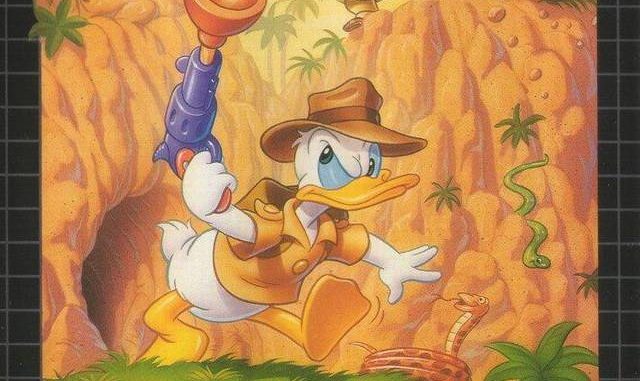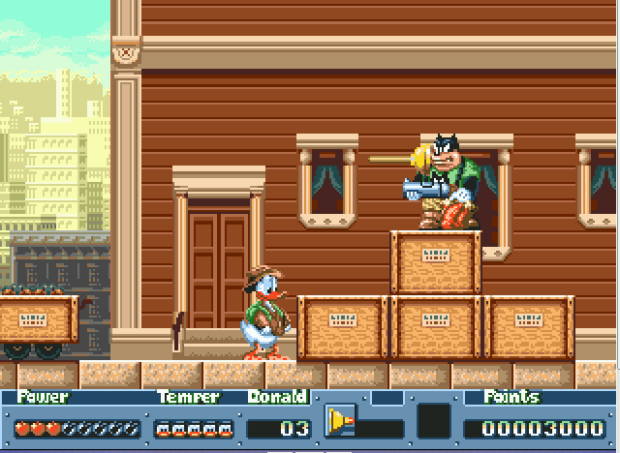
 Released on December 19th, 1991 QuackShot Starring Donald Duck was the first of many Disney games to come to the Sega Genesis during the 16-bit era. Unlike many of the subpar releases by Disney on the original Nintendo Entertainment System, QuackShot featured great graphics, fantastic sound design and character animations that were ahead of its time. But after more than two decades and with many retro titles today receiving remasterings on modern gen consoles, it seems that QuackShot has been left out in this current gaming trend.
Released on December 19th, 1991 QuackShot Starring Donald Duck was the first of many Disney games to come to the Sega Genesis during the 16-bit era. Unlike many of the subpar releases by Disney on the original Nintendo Entertainment System, QuackShot featured great graphics, fantastic sound design and character animations that were ahead of its time. But after more than two decades and with many retro titles today receiving remasterings on modern gen consoles, it seems that QuackShot has been left out in this current gaming trend.Upon closer evaluations, one can plead the case that if any title deserves to be remastered it is Donald Duck’s first great adventure on the Sega Genesis.
Plot
Through the game’s cartoon-like cutscenes, players begin there journey in Uncle Scrooge’s library where his nephew, the titular hero Donald Duck, is rummaging through the miserly old duck’s books in order to pass time. Suddenly, a map falls out of one of Uncle Scrooge’s texts and that leads to the treasure of the Great Duck King Garuzia from ancient times. Seeing this a chance to become rich, Donald sets off on an epic quest to locate the treasure from this ancient Duck society and finally become one of the elites like his Uncle Scrooge.
A simple yet interesting plot that is deeply influenced by the Indiana Jones franchise. Donald is then joined by his three nephews, Huey, Dewey, and Louie as he traverses different locations around the globe from his hometown of Duckburg to the ancient Aztec civilization in Mexico. But what kind of protagonist does not come into conflict with an antagonist? In the midst of all this, Big Bad Pete overhears Donald explaining the legend of the Great Duck King Garuzia and decides to follow the main character and his nephews across the Duck Tales universe.
Gameplay
 Like most games released during its time, Quackshot is an action platformer very similar in vein to the Super Mario Bros. series. Donald travels across a variety of different landscapes, jumping and using his plunger gun to stun enemies as he makes his way from beginning to the end of each level. The level design uses cartoon animation sprites that displayed the full capabilities of Sega’s new 16-bit system. Nonplayable characters (NPCs) come in the form of the above-mentioned nephews of Donald along with eccentric scientist Gyro Gearloose and Goofy, who later gives the hero the plunger bullets that enable him to jump higher during stages.
Like most games released during its time, Quackshot is an action platformer very similar in vein to the Super Mario Bros. series. Donald travels across a variety of different landscapes, jumping and using his plunger gun to stun enemies as he makes his way from beginning to the end of each level. The level design uses cartoon animation sprites that displayed the full capabilities of Sega’s new 16-bit system. Nonplayable characters (NPCs) come in the form of the above-mentioned nephews of Donald along with eccentric scientist Gyro Gearloose and Goofy, who later gives the hero the plunger bullets that enable him to jump higher during stages.
Level Design
In terms of level design, each stage includes a boss battle that can at times be cliche and a rehashing over other notable Disney tropes. For example, Donald travels to Transylvania where of course he ventures into Dracula’s castle where he must face Count Duckula for a specific treasure. This common location was preceded by Capcom on the original NES in Ducktales the video game. It seems that Sega recycled this stage from Capcom which at times can be a bit redundant considering how large the Ducktales Universe can be. But none the less, QuackShot gives pleasures a range of backgrounds that are mostly varied despite its rehashing of older Disney environments. Each level is presented in a side scrolls 2D sprawl as each stage presenting the gamer with an overland part in the foreground and then a background dungeon that the protagonist must complete.
Throughout his quest, Donald is armed with a plethora of weapons that are comical rather than practical. Players can sort between plungers, popcorn and bubble gum projectiles that enable the main character to complete his journey. A miniature airplane is incorporated as a means of travel for Donald as after completing the overland map, the protagonist calls upon his three nephews to transport him to the hidden dungeons that litter the landscape. Similar to what stars do for Mario, chili peppers are scattered throughout each stage which grants Donald temporary invincibility letting off an amazing display of vivid animation from the game’s designers. QuackShot is the pinnacle of everything the Sega did and Nintendo didn’t. Out of the two competing companies during the height of the 16-bit console war, Sega by far produced the greater of Disney inspired titles for its flagship system. QuackShot set the trend for this line of great games that originated from the house that Mickey Mouse built.
Reception and Legacy
Upon its initial release, QuackShot Starring Donald Duck received positive reviews from both fans and video game journalists alike. Journalists praised the game’s graphics and gameplay that were directly taken straight from a Carl Barks magazine strip. While some pointed out the flimsiness of the game’s character movements, these were just a minute part of a much greater puzzle. The praise is due in no small part to the game’s senior artist Takashi Yuda who actually used some of Carl Barks original animations to design the title’s varied landscapes. Although criticized for its simplicity and facile difficulty, QuackShot made the top ten on the Sega Genesis’ greatest games list.
 But after all the praise that poured down on this simplistic yet delightful platformer, QuackShot is not nearly as revered as other Genesis titles like Castle of Illusion or Gunstar Heroes. With modern gamers harkening back to past franchises, it seems that the contemporary climate is perfect for a revamping of Donald’s epic quest through the Duckburg universe. The Disney Afternoon Collection proved that sprite-based graphics and vintage level platforming will never go out of fashion.
But after all the praise that poured down on this simplistic yet delightful platformer, QuackShot is not nearly as revered as other Genesis titles like Castle of Illusion or Gunstar Heroes. With modern gamers harkening back to past franchises, it seems that the contemporary climate is perfect for a revamping of Donald’s epic quest through the Duckburg universe. The Disney Afternoon Collection proved that sprite-based graphics and vintage level platforming will never go out of fashion.Thanks to its hand-drawn animation cells, QuackShot still stands the test of time as a work of art. It embodies a time when the world of gaming was not dominated by first-person shooters and annual sports entries that were as over saturated as they were common. Now more then ever is when the Xbox Live network could use a low budget but high-quality title like QuackShot on its app store. Given the current cultural shift in the consumer market, QuackShot would not only be a much-warranted revisit but a delight for first-time players and seasoned veterans alike.


Leave a Reply